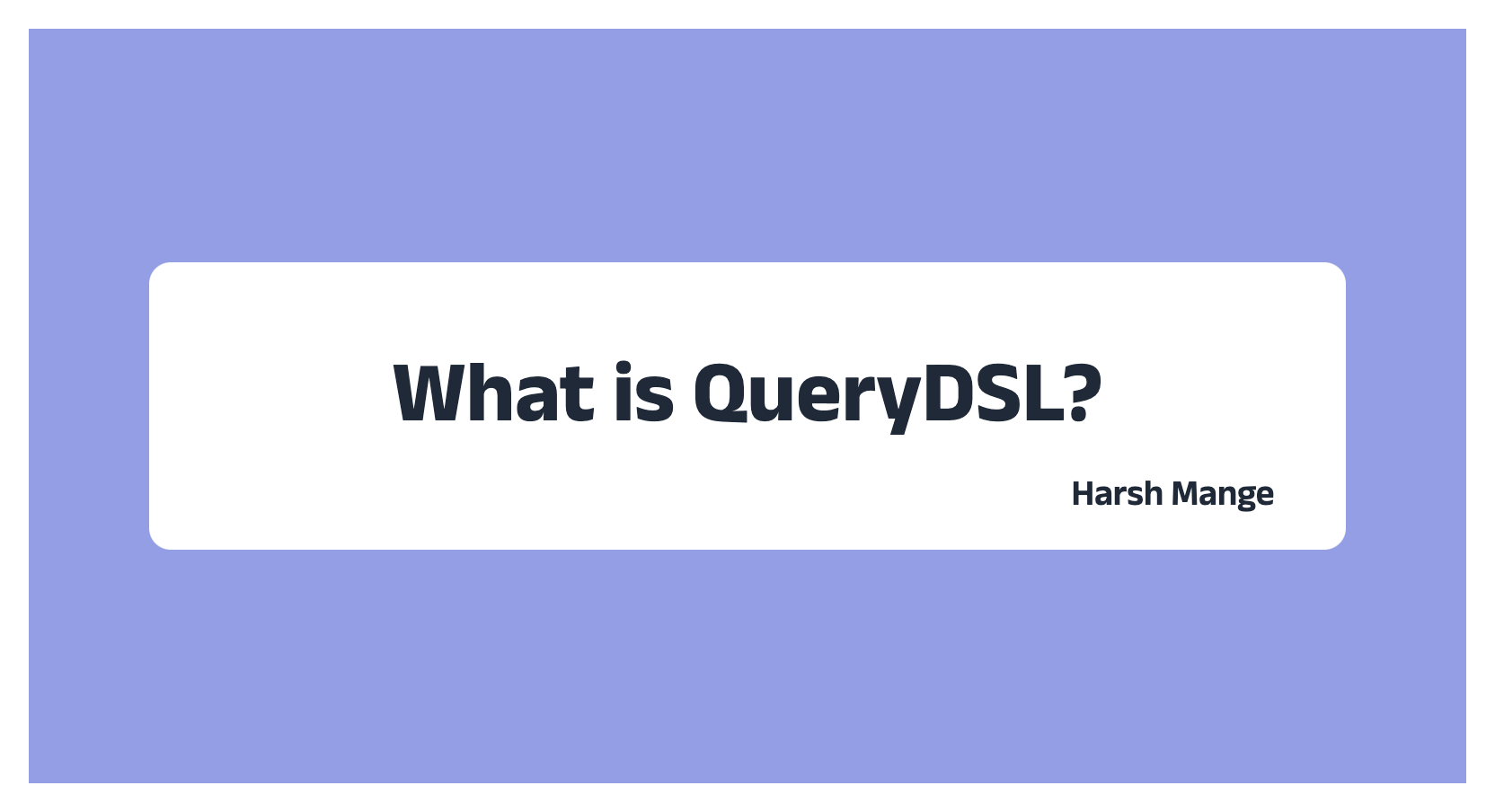Demystifying 'QueryDSL' in Spring Boot: Your Companion for Crafting Intuitive Queries
 Harsh Mange
Harsh MangeTable of contents

Introduction
Ah, the joys of Spring Boot development – the thrill of creating robust applications, the challenges of handling complex databases. If you've ever found yourself wrestling with intricate queries or felt the need for a more friendly way to interact with databases, then it's time to meet your new best friend: QueryDSL.
In this blog post, we'll embark on a journey to explore what QueryDSL is, why it's a game-changer in Spring Boot projects, how it tackles the complexities of production-level databases, and, of course, we'll sprinkle in some basic examples to get you started.
What on Earth is QueryDSL?
QueryDSL is like a wizard for your database queries in Spring Boot. It's a Java library that gives you a superpower – the ability to create SQL and JPQL queries using a fluent and type-safe API. No more wrangling with raw SQL strings or deciphering cryptic JPQL syntax. With QueryDSL, you write queries that feel like a breeze, making your database interactions smoother than ever.
Why QueryDSL? Because We Need Sanity in Our Queries!
1. Type Safety to the Rescue
Imagine a world where your queries are validated at compile-time. No more surprises at runtime, just the warm embrace of type safety. QueryDSL allows you to write queries using Java types, catching errors early in the development process. It’s like having a safety net for your database interactions.
2. Fluent API – The Language of Developers
Say goodbye to the days of convoluted queries that look more like hieroglyphics than code. QueryDSL's fluent API reads like a friendly conversation. You chain methods together, creating queries that are not only powerful but also easy on the eyes. Your queries become a story, not a puzzle.
3. Code Generation Magic
Nobody likes writing boilerplate code, especially when it comes to queries. QueryDSL comes to the rescue with code generation. It can generate query classes based on your JPA entities, saving you from the mundane task of writing repetitive code. Less boilerplate, more productivity – what’s not to love?
Impact in the Real World – Tackling Complex Production Projects
Alright, let’s talk about the real deal – how QueryDSL can be a game-changer in the complex landscape of production projects.
1. Dynamic Queries for Dynamic Projects
In the real world, projects evolve, requirements change, and so do the queries. With QueryDSL’s dynamic query capabilities, adapting to these changes becomes a breeze. Construct queries on the fly based on runtime conditions, because let’s face it, who likes rigid queries in a dynamic world?
2. Joining Forces with Join Operations
Dealing with multiple entities and relationships? QueryDSL makes join operations feel like a walk in the park. Navigate through your data model with ease, perform joins effortlessly, and watch as complex relationships become simple to manage.
3. Readable Code for Sleep-Deprived Developers
In the hectic world of production projects, code readability is not a luxury; it's a necessity. QueryDSL’s expressive syntax ensures that even after that third cup of coffee (or lack thereof), your queries remain readable. Your future self and your teammates will thank you.
Let's Get Our Hands Dirty – Implementing QueryDSL in Spring Boot
Now that we've sung the praises of QueryDSL, let’s dive into the implementation with some basic examples.
Step 1: Add QueryDSL Dependency
Add the QueryDSL dependency to your project. It’s your trusty sidekick, so don’t leave home without it!
<dependency>
<groupId>com.querydsl</groupId>
<artifactId>querydsl-jpa</artifactId>
</dependency>
Step 2: Configure QueryDSL Plugin
Let’s set up the magic – the code generation. Configure the QueryDSL Maven or Gradle plugin in your build configuration.
Maven:
<!-- Inside your plugins section -->
<plugin>
<groupId>com.querydsl</groupId>
<artifactId>querydsl-maven-plugin</artifactId>
<!-- Configuration details here -->
</plugin>
Gradle:
plugins {
id "com.ewerk.gradle.plugins.querydsl" version "1.0.10"
}
querydsl {
jpa = true
querydslSourcesDir = project.file('src/main/generated')
}
Step 3: Generate Query Classes
Run the build to generate the QueryDSL classes. It’s like waving a wand – behold, your queries are ready!
./mvnw clean compile
or
./gradlew clean compileJava
Step 4: Write Your First Query
Enough talk, let’s write a query! Suppose you have a User entity.
@Entity
public class User {
@Id
@GeneratedValue(strategy = GenerationType.IDENTITY)
private Long id;
private String username;
// Other fields and getters/setters
}
Now, let’s find users with a specific username using QueryDSL.
QUser qUser = QUser.user;
JPAQueryFactory queryFactory = new JPAQueryFactory(entityManager);
List<User> users = queryFactory
.selectFrom(qUser)
.where(qUser.username.eq("john.doe"))
.fetch();
Boom! You just crafted your first QueryDSL query. The wizard approves!
QueryDSL Use Cases for Complex Scenarios
Use Case 1: Dynamic Querying with Conditions
Suppose you have a scenario where you want to fetch users based on dynamic conditions, allowing users to filter results based on different criteria such as username, email, and role.
QUser qUser = QUser.user;
QRole qRole = QRole.role;
JPAQueryFactory queryFactory = new JPAQueryFactory(entityManager);
String usernameFilter = "john.doe";
String emailFilter = "john.doe@email.com";
List<String> rolesFilter = Arrays.asList("ADMIN", "USER");
List<User> filteredUsers = queryFactory
.selectFrom(qUser)
.leftJoin(qUser.roles, qRole)
.where(
qUser.username.containsIgnoreCase(usernameFilter)
.and(qUser.email.containsIgnoreCase(emailFilter))
.and(qRole.roleName.in(rolesFilter))
)
.fetch();
In this example, the query is dynamically constructed based on the provided filters for username, email, and roles. The containsIgnoreCase method is used for case-insensitive partial matching, and the in method is employed to filter users with specific roles.
Use Case 2: Aggregation and Grouping
Let's say you want to calculate the total number of users for each role in your system.
QUser qUser = QUser.user;
QRole qRole = QRole.role;
JPAQueryFactory queryFactory = new JPAQueryFactory(entityManager);
List<Tuple> roleCounts = queryFactory
.select(qRole.roleName, qUser.count())
.from(qUser)
.leftJoin(qUser.roles, qRole)
.groupBy(qRole.roleName)
.fetch();
In this example, the query calculates the count of users for each distinct role. The result is a list of Tuple objects, where each tuple contains the role name and the corresponding user count.
Use Case 3: Subqueries for Advanced Filtering
Suppose you want to find users who have a role that is assigned to more than a certain number of users.
javaCopy codeQUser qUser = QUser.user;
QRole qRole = QRole.role;
JPAQueryFactory queryFactory = new JPAQueryFactory(entityManager);
int minimumUserCount = 3;
List<User> usersWithRoles = queryFactory
.selectFrom(qUser)
.where(
qRole.in(
JPAExpressions
.select(qRole)
.from(qUser)
.leftJoin(qUser.roles, qRole)
.groupBy(qRole)
.having(qUser.count().goe(minimumUserCount))
)
)
.fetch();
This query uses a subquery to find roles with a user count greater than or equal to the specified minimum. The main query then fetches users associated with these roles.
Use Case 4: Pagination and Sorting
Imagine you have a paginated UI, and you need to fetch a specific page of users while sorting them by creation date.
QUser qUser = QUser.user;
JPAQueryFactory queryFactory = new JPAQueryFactory(entityManager);
int pageSize = 10;
int pageNumber = 2;
List<User> paginatedUsers = queryFactory
.selectFrom(qUser)
.orderBy(qUser.creationDate.desc())
.offset((long) (pageNumber - 1) * pageSize)
.limit(pageSize)
.fetch();
In this example, the orderBy method is used to sort users by their creation date in descending order. The offset and limit methods are then employed to implement pagination.
Use Case 5: Handling Nested Relationships
Suppose you have a deep relationship structure with entities like Company, Department, and Employee, and you want to find all employees in a specific department of a particular company.
QCompany qCompany = QCompany.company;
QDepartment qDepartment = QDepartment.department;
QEmployee qEmployee = QEmployee.employee;
JPAQueryFactory queryFactory = new JPAQueryFactory(entityManager);
String companyName = "ABC Corp";
String departmentName = "Engineering";
List<Employee> employeesInDepartment = queryFactory
.selectFrom(qEmployee)
.leftJoin(qEmployee.department, qDepartment)
.leftJoin(qDepartment.company, qCompany)
.where(
qCompany.companyName.eq(companyName)
.and(qDepartment.departmentName.eq(departmentName))
)
.fetch();
In this example, the query navigates through the relationships between entities to find employees in a specific department of a particular company.
Conclusion – QueryDSL: Your Database Ally
QueryDSL is more than just a library; it’s your companion in the quest for sanity in database queries. Whether you’re dealing with production-level complexities or just want readable, dynamic queries in your Spring Boot projects, QueryDSL has your back.
So, wave goodbye to query frustrations, embrace the fluency of QueryDSL, and let your database interactions become a tale of simplicity and elegance. Happy querying! 🚀
Subscribe to my newsletter
Read articles from Harsh Mange directly inside your inbox. Subscribe to the newsletter, and don't miss out.
Written by

Harsh Mange
Harsh Mange
This is Harsh Mange, working as a Software Engineer - Backend at Argoid. I love building apps. Working on contributing to open-source projects and the dev community.